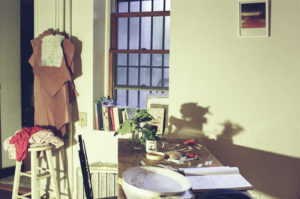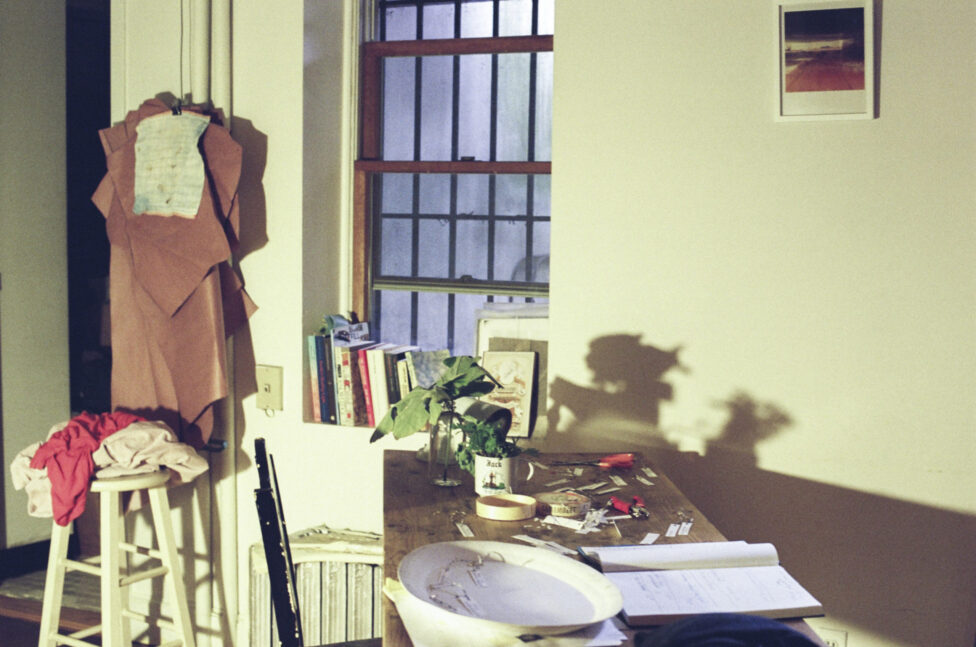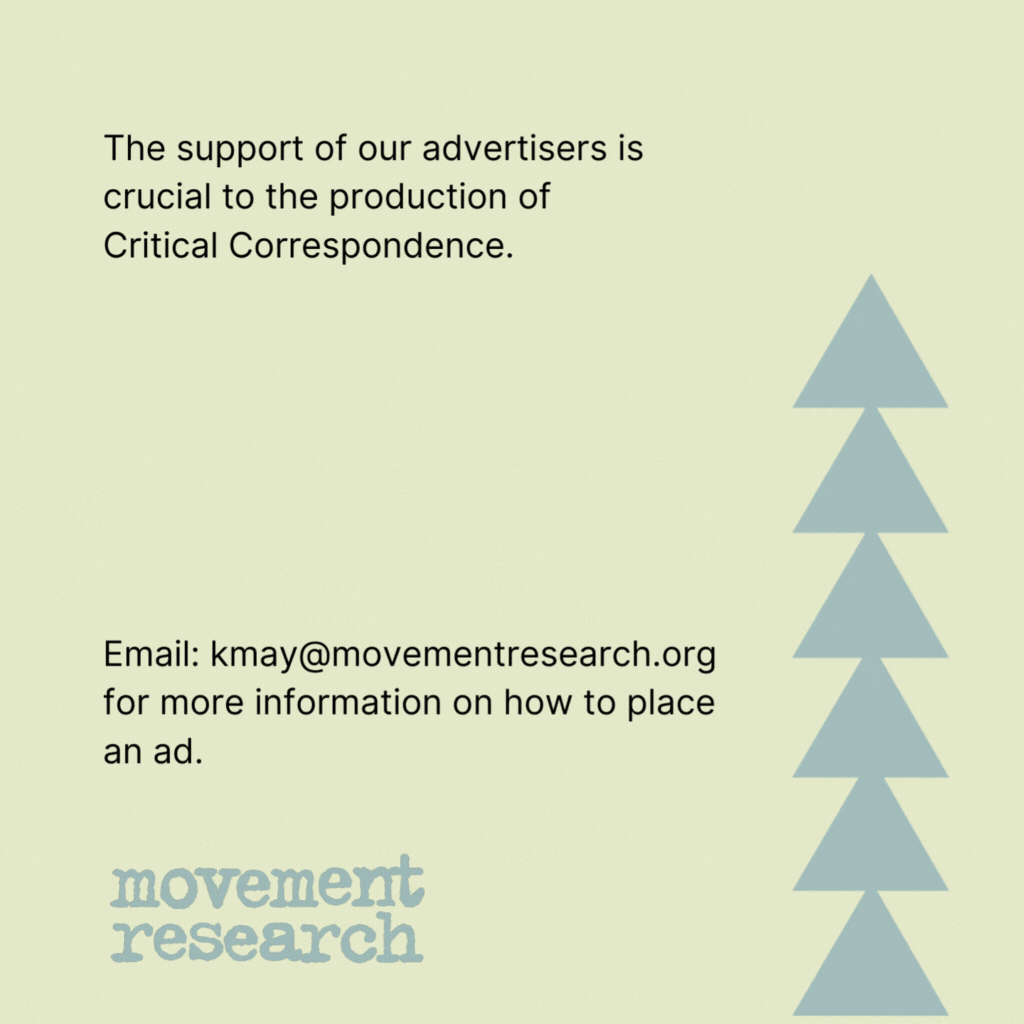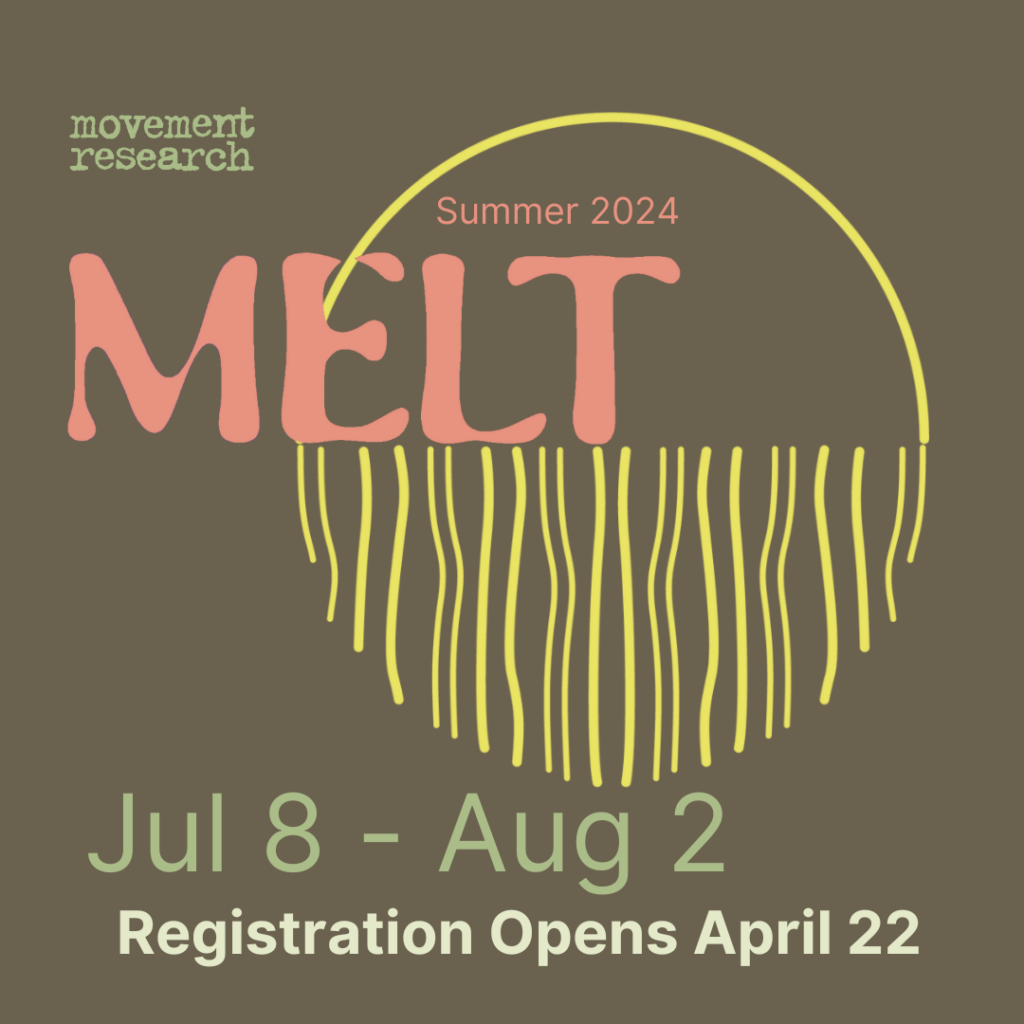Tess Dworman: Can you talk about what the Domestic Performance Agency is?
Athena Kokoronis: The Domestic Performance Agency is a space. It’s a physical space but it’s also a practice that involves choreographic problem-solving with or through domestic strategy. And what that means is emerging through practice. I came up with the name, Domestic Performance Agency, first and then this idea of a choreographic problem and then being committed to choreographic problem-solving and then domestic strategy. I made up all of these terms and named things and now I’m trying to figure out what it is. [I do] introductions. Introductions are these one-on-one performances— they’re kind of like performance consultations— there’s a little dance. We talk about what a choreographic problems might be. The Domestic Performance Agency was also instigated by becoming a mother. It’s working with motherhood and artist hood— containing them, or not containing them— playing around with the boundaries a little bit. I’ve done over 50 introductions since January 2015. One specific choreographic problem for me is time, which has something to do with duration, a relationship to duration, I mean we could go on about time. Last night for Holding it Together with Laurel Atwell we served thyme tinctures. One was concentrated with thyme and one was a diluted thyme.
TD: Like the herb.
AK: Yes. But we could wordplay with that. Here’s a diluted version. So time and art practice and motherhood. Then there’s sensitivity. This relationship with the senses.
TD: Sensitivity as a choreographic problem?
AK: As a choreographic problem. And when I say problem I’m thinking of it more in scientific terminology. Sensitivity having to do with porousness— the relationship with the senses in “contemporary experimental dance practice”. And intimacy. This relationship to audience. Proximity— things that are hard to see. So these are choreographic problems. And then I think about domestic strategy. Do you want to me keep going? Do you want me to pause?
TD: Let’s see… yea, maybe let’s pause for a second.
AK: Ok.
TD: So, choreographic problem solving. The problems are time, sensitivity, intimacy— things that are hard to see. And you said something about how it’s a scientific way of looking— so calling the problems, the different variables basically…
AK: Or maybe they’re prompts. I have this scroll and everytime I do these introductions the scroll comes out. So these are all possible choreographic problems. It’s like:
Loved with the loved ones/ home and domesticity/ to be domestic/ pleasure/ searching for the gesture within materiality/ The menu today/ Dance search next to body’s need/ Trust/ Who are the performers? / Promise, as an agent I promise / Vulnerability/ Invisibility/ Collaboration/ How do durations work with and against/ emptiness fullness/ how to hold it together?
There it is. I mean there are hundreds of problems. And they’re probably a lot we haven’t noted yet at the DPA.
TD: Yeah the things that are hard to see… this is a way of identifying those things. That really makes sense to me as a way of looking because dance doesn’t really deal directly with anything so a lot of problems can arise.
AK: Yeah!… I forgot to say that the Domestic Performance Agency is for me a searching for a dance. I’m searching for the dance. I don’t know what the dance is, but I think…“what is a dance?” But it’s not so fun to answer or to stick to that question. I’d rather explore it through doing and just being fully immersed in moving. At one point since the DPA I began to think about quotidien dance and dance magic. Quotidien dances come from many years of just working with food and thinking about the table as a daily stage. I’ve got lots of visual cues here. I’m just going to pull these out. Ever since I’ve lived in New York, the home and cooking have always been this relationship of this daily stage that happens potentially three times a day if we’re lucky. I’m working from a privileged place being able to eat three times a day. This kind of quotidien dance in preparation of food. Cleaning. Just pulling it all down. All the props are around us. I’ve created my own agency here. I worked as a domestic laborer for many years. I’ve worked for a lot of artists who had studios in their homes. Housecleaning. Dust. The relationship to dust. And this dance that’s hard to see. Dust has this quality of being very still and moving and landing somewhere else. Then becoming still. This constant moving of this thing that you can’t see sometimes unless you’re deeply focused. You’re in deep, you’re in close proximity with the dust.

TD: Could you talk about domestic strategy and how you apply that to all of it? To these choreographic problems?
AK: We’re starting to get into it because this legacy of domestic labor— I’m working with that. I’m looking at it. Specifically as artists who are mothers. I worked for these three women who were artists, mothers and who had studios in their home and who offered me an entry point into defining Domestic Strategy.
TD: Who are they?
AK: J. Morgan Puett. When I first graduated from art school I worked for her as a nanny. She eventually started this… well, where is it? [looks for book] I can’t find the Mildred’s Lane book. She started Mildred’s Lane. It’s this 91 acre… it’s a “contemporary art complex-ity”, she calls it. This is one of her projects. [looking around] I can’t find the Mildred’s Lane catalogue.
Her domestic strategy has something to do with everywhere you go you wear your practice. She works as an installation artist and had shop installations in New York in the 90’s where she would make clothes. So this literal, “wearing your practice”, but also bringing her practice home to Mildred’s Lane. Naming her space Mildred’s Lane and having sessions throughout the year where artists and other thinkers and community members, activists come and work together on collaborative projects on the land. But at the heart of one of her choreographic problems would be radical domesticity.
She lived there with her partner/collaborator, Mark Dion, for many years and when they broke up that was when Mildred’s lane officially started. So it’s kind of like a divorce contract that’s holding it together, preserving their history as collaborators, parents to their son, buying land together. Morgan and Mark both collectors, building buildings that contain the collections, and the history in part of the material culture. That’s always been there. Through Mildred’s Lane, I worked as a digestion choreographer as well. So I was cooking at an artists’ home turned complex-ity.
To work with food, it’s like appetite doesn’t get cancelled, you can’t cancel appetite. So this relationship to… there’s soup upstairs, in a pot if you need some soup, Laurel.
Laurel Atwell: Great!
AK: Are we doing ok on time?
TD: Yeah, we’re great.
AK: I worked for Morgan, for many summers, many years. Through Morgan and Mark, I met Moyra Davey. At some point she was diagnosed with MS. She hired me to be her house keeper. Her domestic strategy has something to do with composure in the un-composed. She’s a photographer. Photographing her home and books and pages and little scraps. She’s a voracious reader, one of her first projects was Mother Reader, An Anthology, Essential Writings on Motherhood. But some of her photographs…[shuffles around, flipping through Davey’s book] in here… that’s her rug. I vacuumed that rug. This relationship to sensitivity…how deep to go… how deep to penetrate the dust under the bed. [She] is a photographer working with dust, which is a nightmare to a lot of photographers, especially people that are still working with film.
Her studio was a house, or an apartment, it was in her house, but the boundaries were smaller than Morgan’s practice, which was 91 acres. So, this idea of composure and the uncomposed, what that might look like, that’s something that we’re working through. It’s in the piece that Laurel [Atwell] and I are doing but maybe it’s more about holding it together, and it’s collaborative.
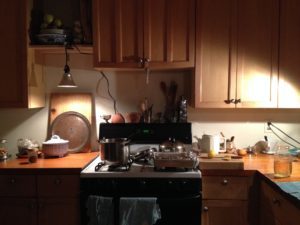
AK: Rebecca Quaytman is a painter that I worked for. I was cooking for her. I was her studio assistant in the kitchen. These women are all recognized art world figures. They’ve all shown at MOMA. Rebecca’s current show is at MOCA in LA. Her domestic strategy is about holding space with a method, “through a method”. She corrected me, I used to say “system” because I’m thinking of the human system. “Method” is what she would call it. She calls her body of work “a book,” and every time she’s invited to do another exhibit she does a chapter. So it’s unending now. She keeps going. This method of going places. Working , processing through readings/research, looking at engravings, textiles, personal relationships, genealogy, Holding the space with this. The architecture, photography, screen printing, going in with her hand with the paint. Onto the wooden surfaces of rectangles or squares. Her paintings are abstractions and the surfaces are crazy beautiful. And she thinks about storage as well. The archiving and the edges are really important in her painting what looks like an an edge is sometimes found in the foreground of her paintings and it’s all able to be held through these formal choices that she makes.
TD: You said it was J. Morgan Puett who said that domesticity is radical, or something, or that was your take on it?
AK: She’d say, no one knows, or no one thinks about it but domesticity is radical.
TD: Why is it radical, what is it a rejection of, working out of your home or creating these domestic strategies? What is it a reaction to?
AK: Well before you came, I was upstairs. We didn’t talk about the physical space of the Domestic Performance Agency but, this is a ground level apartment unit in a brownstone that my partner owns. And it used to to pay the mortgage, but now the mortgage is paid. He bought this place in the nineties when Prospect Heights was affordable to people that had some kind of savings. I moved here in 2010, a year before I got pregnant and then I got pregnant. And making time to make art is really hard. So one thing, it’s being ok with working from home. Being able to work feels radical sometimes. We were talking about slogans, and my partner’s been having trouble getting going. He’s older than me and he’s a white man, a writer and I gave him a slogan today, “Bring back the white man!”. They’ve been in charge for so long, and I was being ironic, but he was laughing…I don’t know. I come upstairs after my show and the kitchen’s a mess, and it’s like what do I do? To be able to just… hold this together with being so close to home. I really do want to show at The Kitchen. I would love to stage a piece for The Kitchen in Chelsea, but there’s also this kitchen, and I think it’s radical to think about, or not worry about, not yearn all the time or really need to be in these institutions that are already set up for us. Hospitality too, it’s a real…almost like a choreographic rite. The thing about Morgan, Morgan is really intense. She’s an intense, passionate…some people call her crazy… she shares everything. But I don’t know, sharing sometimes feels radical in this day and age. In New York City, it’s really hard to share at the Kitchen, Danspace, Judson…how many experimental dance venues are there? And this [space] feels really fertile…we have this space, we have space in New York, so sharing is what feels radical about domesticity now. Sharing aesthetics. Before Laurel came it was all white in here. It was very bare bones, skeletal. Laurel’s brought so much color to this space.
Laurel: really…
AK: And chaos! It’s being ok with chaos. Having to start over every day.
TD: That’s great.
AK: Oh here’s another thing. I feel like we’re throwing a little stone and and just making a little ripple. This idea of copying. I feel like I’m not doing anything different but it’s a different outcome, to have role models and to celebrate legacy. I feel like there’s so many people who just want to cancel out what happened before but nothing’s new. Laurel would agree with this…
TD: Yeah, there are different ways of dealing with that fact.
AK: Nothing’s New! Get over it!
TD: You did say a while ago that this space is a dedication to those three artists. Would you think of them as your role models?
AK: Oh yeah.
TD: And you were, in a way, honoring what they were doing by kind of copying?
AK: More like a celebrating or an acknowledgement, yeah.
